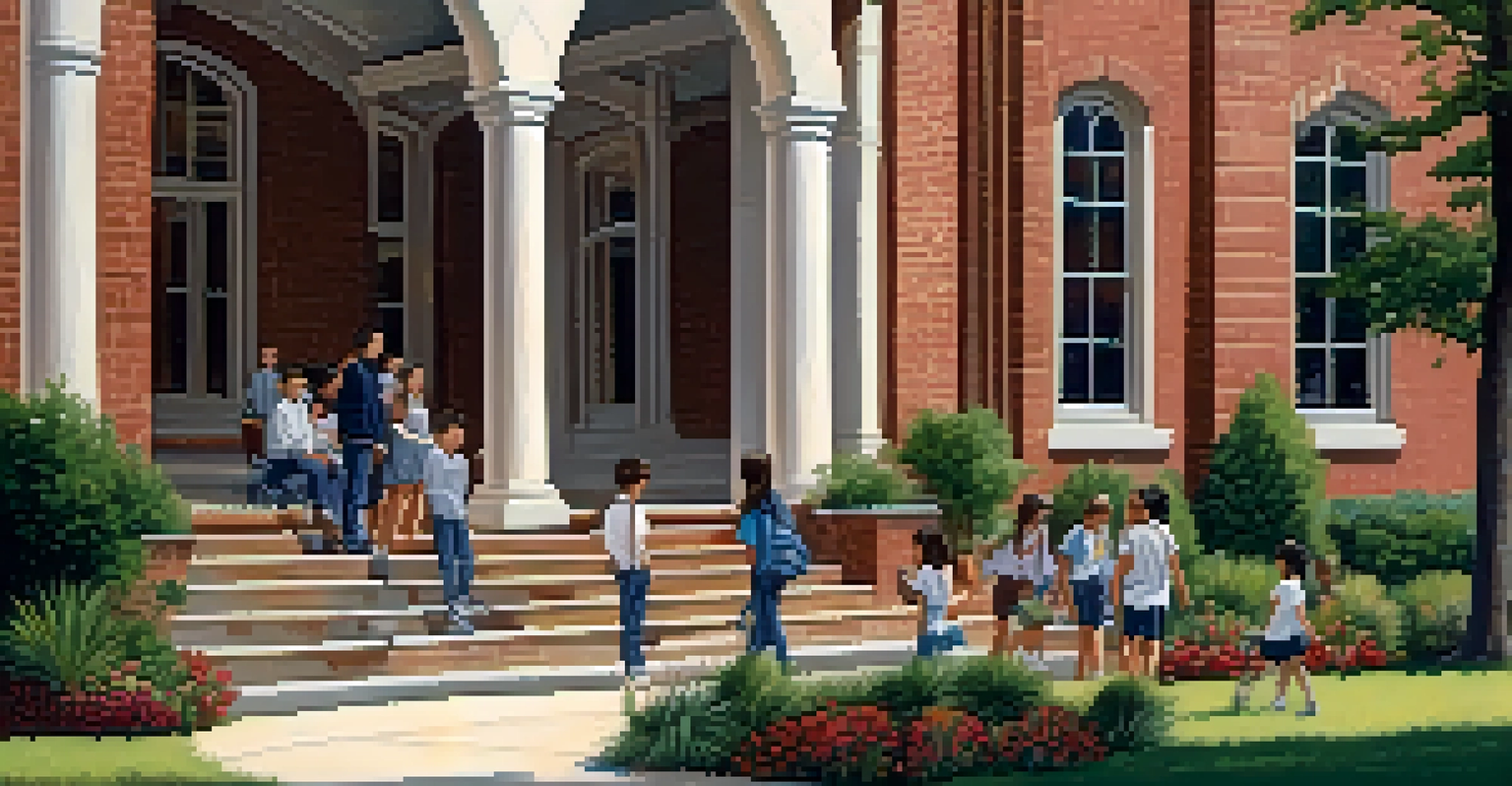Private vs. Public Schools in San Antonio: Key Differences

Understanding Public Schools in San Antonio
Public schools in San Antonio are funded by state and local taxes, making them accessible to all students without tuition fees. This system aims to provide a free education to every child, regardless of their background. Public schools often follow standardized curricula set by the Texas Education Agency, ensuring a uniform educational experience across the district.
Education is the most powerful weapon which you can use to change the world.
In addition to being tuition-free, public schools typically offer a diverse range of programs and extracurricular activities, reflecting the community's demographic mix. This diversity can foster a rich learning environment where students interact with peers from various backgrounds. Moreover, public schools are required to accommodate students with special needs, providing necessary resources and support.
However, class sizes in public schools can be larger, which may impact individual attention from teachers. Families often consider the student-to-teacher ratio when evaluating schools. Overall, public schools aim to provide quality education while adhering to state regulations and community needs.
Exploring Private Schools in San Antonio
Private schools in San Antonio operate independently of the public school system and rely on tuition fees, donations, and private funding. This financial model allows them to create specialized programs and curricula that may not be available in public schools. Many private institutions pride themselves on small class sizes, offering personalized attention and tailored learning experiences.

One significant advantage of private schools is their ability to implement unique educational philosophies, such as Montessori or Waldorf methods, which can resonate with certain families. These schools often have the flexibility to adapt their curriculum to meet the specific needs of their students, fostering a more engaging and individualized learning environment. Additionally, private schools may have more control over admissions, allowing them to create a selective community.
Public Schools: Accessible Education
Public schools in San Antonio provide a tuition-free education funded by state and local taxes, ensuring accessibility for all students.
However, the cost of tuition can be a barrier for many families, making private education less accessible. This financial aspect leads to a more homogeneous student population, which may limit diversity compared to public schools. Ultimately, the decision to choose a private school often hinges on the values and priorities of the family.
Curriculum Differences: Public vs. Private
Curriculum design is one of the most notable differences between public and private schools in San Antonio. Public schools follow a state-mandated curriculum focused on core subjects like math, science, and language arts, with standardized testing to measure student progress. This ensures that all students receive a consistent educational foundation, but it can also limit flexibility.
The beautiful thing about learning is that no one can take it away from you.
In contrast, private schools have the freedom to choose their own curriculum, often emphasizing specific subjects or skills that align with their educational philosophy. For instance, a private school might prioritize arts education or foreign languages, providing a broader range of subjects that may not be as emphasized in public schools. This flexibility can cater to a range of student interests and strengths.
However, the lack of state oversight in private schools means that the quality of education can vary significantly. Families should research and evaluate the curriculum of private institutions to ensure it meets their expectations. Ultimately, the choice between the two often comes down to the educational goals and values of the student and family.
Class Size and Student-Teacher Ratios
Class size is a crucial factor for many families when choosing between public and private schools in San Antonio. Generally, private schools tend to have smaller class sizes, allowing for more individualized attention and closer relationships between teachers and students. This can lead to better academic support and a more personalized learning experience.
Public schools, on the other hand, often have larger class sizes due to budget constraints and higher enrollment numbers. While many public schools strive to maintain a favorable student-teacher ratio, it can sometimes be challenging to provide the same level of individual attention as private institutions. This difference can significantly impact a student's educational experience.
Private Schools: Specialized Learning
Private schools operate independently, offering specialized curricula and smaller class sizes, but require tuition, which can limit accessibility.
Smaller class sizes in private schools can also foster a more intimate learning environment, encouraging participation and collaboration. Families should weigh the importance of class size against other factors, such as curriculum and school culture, to determine the best fit for their child's educational journey.
Diversity and Inclusion in Schools
Diversity is another significant consideration when comparing public and private schools in San Antonio. Public schools are typically more diverse, reflecting the demographics of the community. This diversity can enrich the learning experience, exposing students to various cultures, perspectives, and backgrounds, which is essential in today’s interconnected world.
Private schools, while they may offer exceptional educational programs, can sometimes lack the same level of diversity. The tuition cost can create a more homogeneous student body, which may limit students' exposure to different viewpoints. However, some private schools actively promote diversity through scholarships and outreach programs to attract a wider range of students.
Ultimately, the importance of diversity in education varies for each family. Some may prioritize a diverse, inclusive environment in their child's education, while others may focus more on academic rigor or specific educational philosophies. Understanding how each school approaches diversity can help families make informed decisions.
Costs and Financial Considerations
When it comes to costs, public schools in San Antonio are funded through taxes, meaning they are free for families to attend. This makes public education accessible for all, which can be a significant relief for families on a budget. However, there may still be fees for extracurricular activities, uniforms, and school supplies that families should be aware of.
In contrast, private schools typically require tuition payments, which can vary significantly based on the institution. Families must consider their financial situation when deciding on private education, as tuition can be a substantial investment. Some private schools offer scholarship programs to help alleviate costs, but these may be limited in availability.
Diversity in School Environments
Public schools tend to be more diverse, reflecting community demographics, while private schools may lack this diversity due to tuition costs.
It's essential for families to evaluate the long-term financial commitment of choosing a private school versus the free option of public education. Understanding the full cost picture, including potential hidden fees and additional expenses, can help parents make the best decision for their situation.
Extracurricular Activities and Student Life
Extracurricular activities play a vital role in a child's education, providing opportunities for socialization, teamwork, and skill development. Public schools in San Antonio often offer a broad range of extracurricular options, from sports and music to clubs and academic competitions. These activities can help students discover their interests and passions beyond the classroom.
Private schools also offer extracurricular activities, but the variety may differ based on the school's focus and resources. Some private institutions excel in specific areas, such as arts or athletics, providing students with unique opportunities to develop their talents. However, the availability of extracurricular activities may be more limited compared to public schools.

When considering school options, families should explore the extracurricular offerings at each institution. A well-rounded education includes opportunities for personal growth outside the classroom, and understanding what each school provides can help families choose the best fit for their child's overall development.